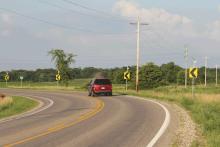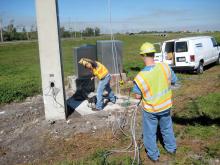A study by the US Federal Highway Administration’s Highways for Life has found a small but consistent reductions in mean and 85 percentile speeds on dangerous bends through the use of Tapco’s BlinkerChevron dynamic curve warning and guidance system (DCWGS) instead of static warning signs.
The system's detects oncoming vehicles up to 90m (300ft) from the curve and will trigger the flashing LEDs on the signs if the vehicle’s speed exceed a predetermined level to warn the driver of the dangerous curves with e
A study by the US Federal Highway Administration’s Highways for Life has found a small but consistent reductions in mean and 85 percentile speeds on dangerous bends through the use of 989 Tapco’s BlinkerChevron dynamic curve warning and guidance system (DCWGS) instead of static warning signs.
The system's detects oncoming vehicles up to 90m (300ft) from the curve and will trigger the flashing LEDs on the signs if the vehicle’s speed exceed a predetermined level to warn the driver of the dangerous curves with each chevron flashing sequentially.
Set up to examine improving safety performance on rural horizontal curves, the study concluded that ‘overall, the sign appeared to be effective in reducing speed and crashes’. Analysis showed a reduction in vehicles exceeding the speed limit or advisory speed limit by 5, 10, 15, or 20 mph, and particularly in the higher ranges.
The system's detects oncoming vehicles up to 90m (300ft) from the curve and will trigger the flashing LEDs on the signs if the vehicle’s speed exceed a predetermined level to warn the driver of the dangerous curves with each chevron flashing sequentially.
Set up to examine improving safety performance on rural horizontal curves, the study concluded that ‘overall, the sign appeared to be effective in reducing speed and crashes’. Analysis showed a reduction in vehicles exceeding the speed limit or advisory speed limit by 5, 10, 15, or 20 mph, and particularly in the higher ranges.










